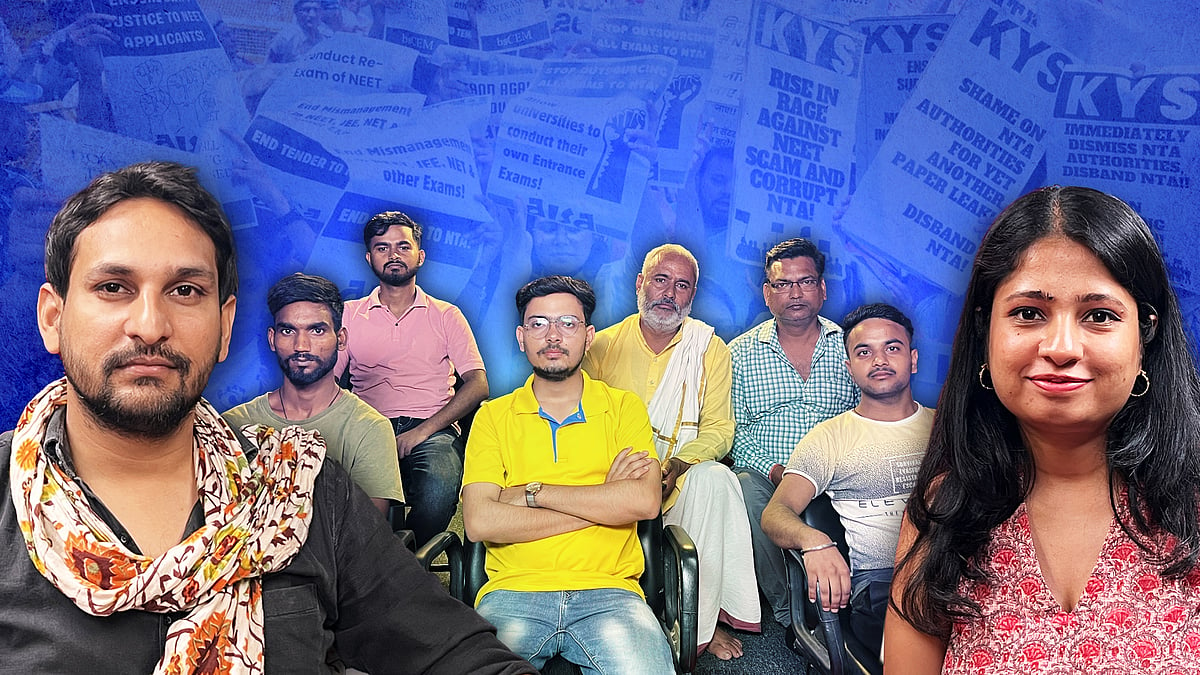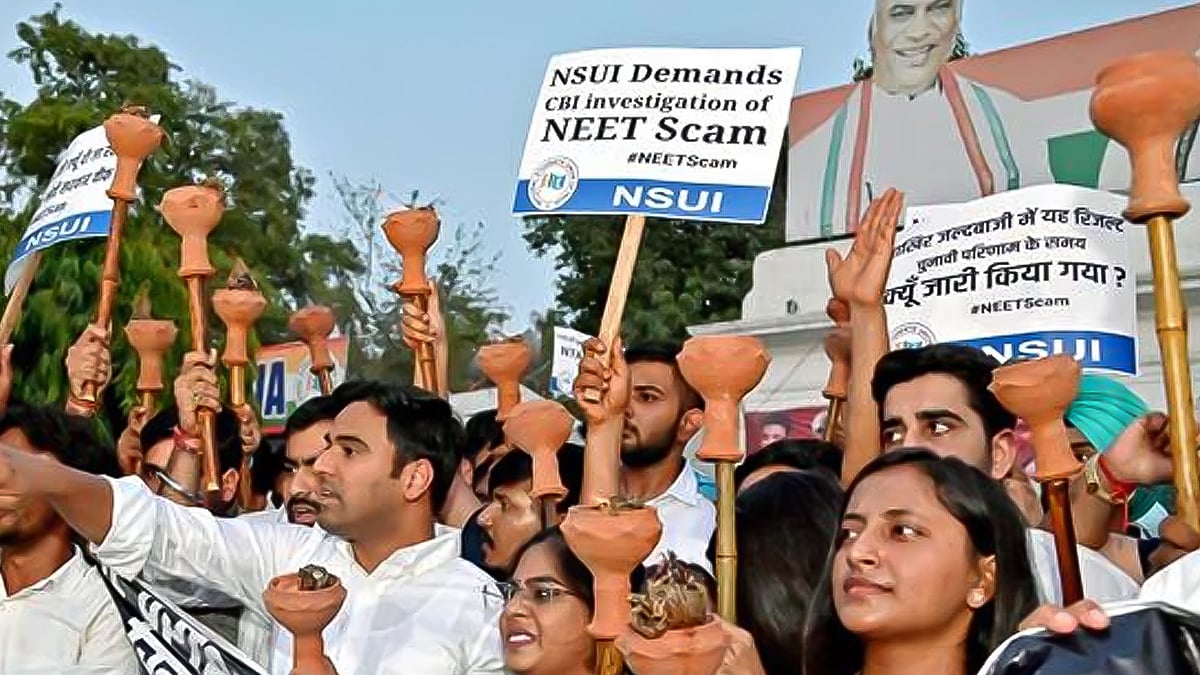Pedagogy, jobs, reform: The many reasons why UGC-NET is a study in failure
One of India’s largest public exams to test higher education entrants pays short shrift to teaching’s quintessence.
The University Grants Commission-administered and the National Testing Agency-conducted National Eligibility Test was cancelled just a little after the NTA-coordinated National Eligibility cum Entrance Test’s last-minute annulment – after it was revealed that question papers were leaked and both examinations compromised.
These exams engender incredible anxiety for students whose futures depend on them. For lakhs, these were jolts costing them hard-earned money to write the exam, travel from faraway villages and towns to the exam centres and attend coaching classes. It wasted priceless months of their lives. And now, the largest democracy in the world seems listless to harness the much touted ‘demographic dividend’ of young India.
While both the botched public exams impair India’s governance standing, there are many legitimate considerations from several standpoints to be unpacked.
This essay shall confine its focus to the UGC-NET, and later the matter of pedagogy.
Behind the anger
On social media, Indian postgraduate students in public universities took the Ministry of Education (MoE) and the NTA to the skewers for what transpired. While doing so, they disputed the flaws and merits of the UGC-NET’s testing methods and questioned if a two-part three-hour public examination mode was appropriate to fashion them for the higher education vocation. The invalidated UGC-NET had record numbers writing it.
Numerous Indian students and scholars in India and elsewhere lampooned the UGC-NET for being a poor way to usher in fresh blood into higher education. There were several others calling out those who were calling out an admittedly clunky and malfunctioning assessment system – their caste, class and educational advantages generally permitted the critics of the UGC-NET to leverage their network with the academe and get ahead in it in India or elsewhere. They asked: What about the general majority from non-elite India who had few means to crack open the higher education door, except through the UGC-NET? Hundreds of coaching classes (online as well) mushroom across India for this reason.
If a postgraduate student under the age of 30 gets a good rank, they qualify for the Junior Research Fellowship (JRF) and obtain a stipend that hopefully sees them through one’s research degree years.
These are bread-and-butter matters for lakhs of non-elite Indian students in their 20s and early 30s. These are years when they may even attempt the civil services examinations, train on becoming better teachers and researchers. A part of the JRF may go home to support an ailing parent or for the wedding of a sibling, and so they work alongside academics for extra pay. For young women, it’s a way to assert their freedom, build their own future, and hold off social pressures from back home to “settle down” when they don’t feel the time’s right.
A cliché and serious questions
The cliché of the Indian humanities or social sciences postgraduate in a public university as a slacker leaching taxpayers’ monies is one of the grossest falsifications mainstreamed in the last 10 years. In national popular discourse this person is no longer pictured as a human being. So, in a way, with all its faults, the UGC-NET is a kind of equaliser. To advance a sort of level playing field, the competitive public exam is the sole means to achieve it. But did it have to be so?
Not really.
What rationale informs the UGC-NET exam? What is it responding to and trying to achieve?
The UGC-NET is triple-purposed. It helps decide if a) a candidate can qualify as an assistant professor which is the starting teaching position in universities, b) is entitled for the JRF, c) aid in PhD admissions. In fact, these rules apply to many but not all private universities as well. Yet it stalls from taking the educational bull by the proverbial horns. In his insightful article from 2017 sociologist Avijit Pathak says this about the UGC-NET, “The fact is that it prevails because its primary goal is not to evaluate, but to eliminate people as quickly as possible; it is like any other large-scale competitive examination that needs only a programmed machine to filter people.”
How can one be sure that a student who has cleared the UGC-NET can actually teach? Or do research? By mostly answering correctly to multiple choice-based questions in three hours can one conclude with conviction that a student is ready for teaching?
Teaching quality has declined and experts have impressed on the subject often. Many leading lights in education question the thinking behind the UGC-NET as it absolves accountability from colleges and universities and the MoE.
UGC-NET barely skims the surface when it comes to pedagogy
The real query over the UGC-NET is: How do we train and ready teachers in higher education for a life teaching at a college or university, while becoming able researchers and genuine contributors to the intellectual loads of their terrain? Does the UGC-NET speak to those essentials and answer to it comprehensively, comprehensibly, and cogently? It does not.
It barely skims the surface on the idea of pedagogy – the framework of teaching and learning.
To enable this, pedagogical methods, ‘shadowing’ teachers and co-creating a capsule of a class they teach, needs including in the postgraduate coursework. The postgraduate student ought to get eased into the craft of teaching the fundamentals of their discipline as they deepen their ken. For instance, the North American 5-to-7 year-long doctoral programme in the humanities and the social sciences.
In its prime, most North American universities fully funded the doctoral candidate, who became an employee and stakeholder in the institution. The student did coursework, taught basic courses to undergraduates, participated in seminars and conferences, learned a language (if required) for the fieldwork, while polishing their hypothesis, expanding their literature review in the area and getting up to speed on contemporary developments in the discipline, the minutiae of its evolution, and built relations with scholars. By the end, you got an individual capable of contributing to the academic community and students in versatile intellectual ways. It couldn’t happen without a vigorous educational ethos already in place.
The UGC-NET, like some of the other teacher qualifying exams, runs short shrift on pedagogy, because it’s the foremost distressing matter. Quality pedagogical training presupposes immense intellectual, economic outlay and emotional commitment on the part of the higher education institution.
Further, there are few immediate or tangible quantifiable returns on such investment, but unmissable long-term benefits. The Indian Institutes of Technology, the Indian Institutes of Management, the All-India Institute of Medical Sciences and Jawaharlal Nehru University , to name some, are apt exemplars of just that. They were nurtured and flourished well before UGC-NET like exams arose for them to pick faculty.
So then, what are some of the ways out of this morass?
Stop misleading, push for scholarship, pedagogical training
First, address if Indian society really needs the arts, the fine arts, the humanities or the social sciences graduates, at all in the first place? Because graduates in these fields generally struggle for employment, and academic hiring has worsened. The pace of academic and related jobs has not kept up with the numbers of people graduating in the humanities and social sciences every passing year. The government and HEIs mustn’t mislead them anymore. A postgraduation in a discipline must lead to some germane job in the field.
For instance, a philosophy (an unfortunately less popular subject) postgraduate must get the opportunity to be employed as a philosophy scholar in the making in some university department. The job has to be created for that person, or a department formed to absorb that individual. Else, call for an all-stakeholders meet with public universities, and drop such subjects altogether. For young and not so young students, learning absolutely must lead to meaningful employment in that discipline. Ramp up hiring for there are many public HEIs facing faculty shortage.
Second, show love, respect, encouragement and investment, to scholarship and creativity. Mean it. During its zenith in the last century, the Western nations contributed heavily in ideas and creativity of all kinds, in particular education. America is a giant, though a more circumspect one now, as it was an educational superpower for nearly 100 years and permitted international talent. The UGC-NET is a confidence deflating exam for most Indians, because they know even if they pass it, they may not obtain immediate employment that is owed to them. Comparatively, a Western student of higher education, is invariably made to feel more empowered even as an international student, than say an Indian postgraduate student at even one of the top public universities in India. The UGC must make that transition happen really soon.
Third, include pedagogical training in disciplinary learning. Can a postgraduate in literature become qualified to teach at a school, if not college or university? Rethink postgraduate syllabi in the light of employability and embed those capacities in the learning.
Fourth, students and teachers of India must push their political representatives to pressure governments to radically expand the higher education budgetary outlay.
Notwithstanding its field-levelling attributes, a catastrophe of the educational imagination as the UGC-NET cannot be the touchtone to usher new people into teaching.
The writer has taught at two private universities in India, and is a poet, teacher, and writer in Bangalore.
In times of misinformation, you need news you can trust. We’ve got you covered. Subscribe to Newslaundry and power our work.
 ‘Not students, it’s about 25 lakh families’: Aspirants on NEET hopes, hype and harm
‘Not students, it’s about 25 lakh families’: Aspirants on NEET hopes, hype and harm After NEET, UGC-NET row, Bihar’s TET cancelled over ‘unavoidable circumstances’
After NEET, UGC-NET row, Bihar’s TET cancelled over ‘unavoidable circumstances’